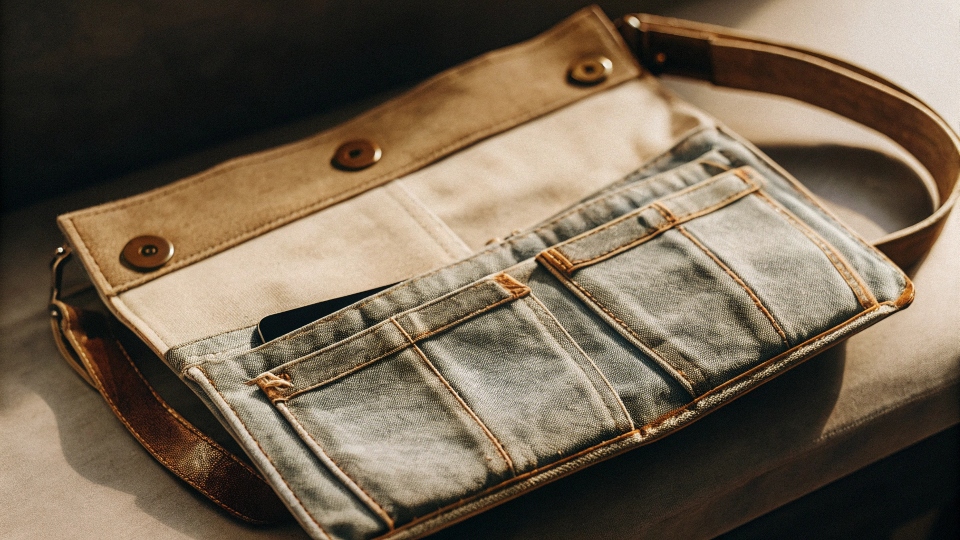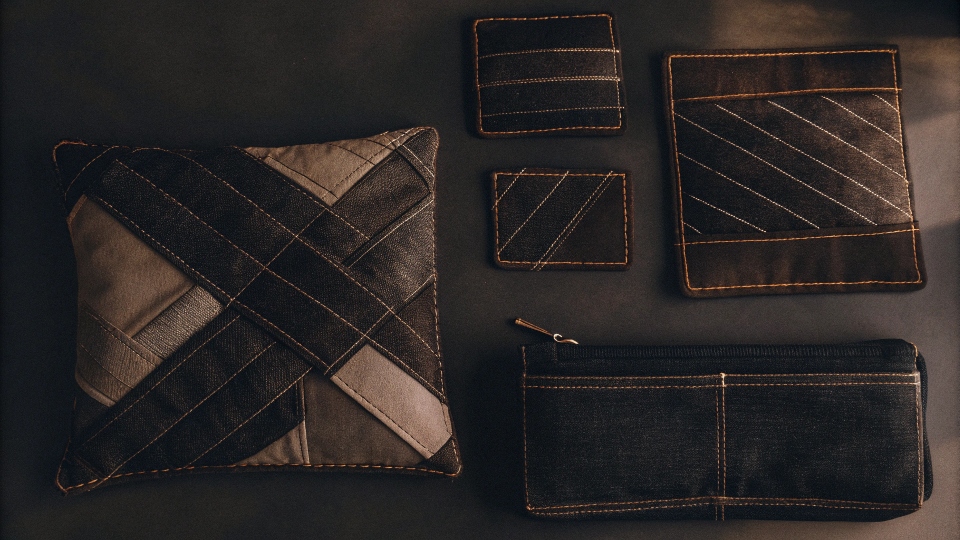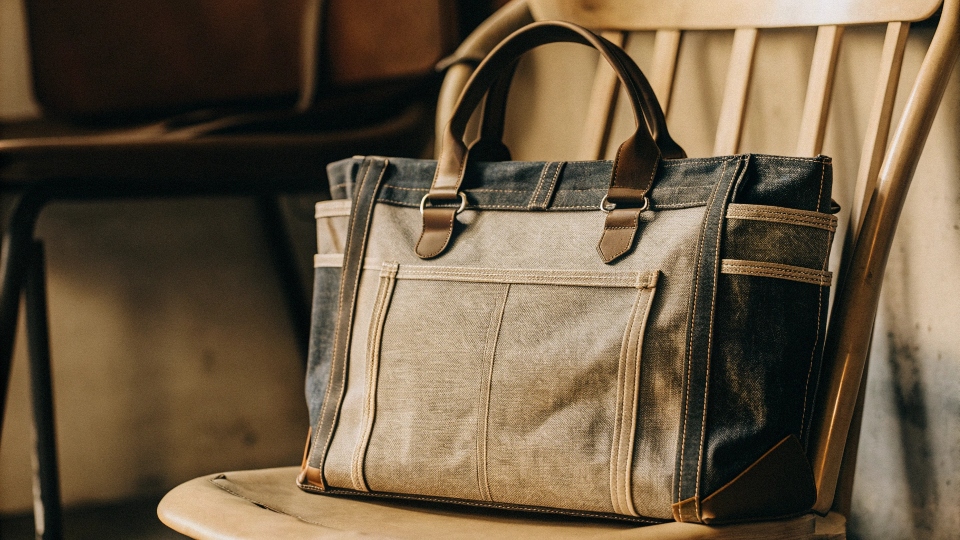Your favorite jeans don't fit, but the fabric is too good to waste. They sit in a drawer, taking up space, a constant reminder you need to do something with them.
To make a simple purse from old jeans1, cut the top part of the jeans off below the crotch. Turn this section inside out, sew the bottom opening shut, and use the existing belt loops to attach a strap. This creates a functional bag with ready-made pockets.
I’ve spent my entire career—over 20 years now—at my denim factory, DiZNEW. I’ve seen denim transformed in every way possible. The most satisfying projects are often the simplest.
My good friend Dean, a top denim design2er, always says that the best designs are born from clever constraints. Using an old pair of jeans as your starting point is exactly that.
You're not just making a purse; you're giving a story-filled piece of fabric a second life. I'm going to show you the easiest way to do it right, so your finished purse looks intentional and stylish, not just cobbled together.
How to turn a pair of jeans into a purse?
You love the idea, but you're worried about complex patterns and messy cutting. You want a straightforward process that guarantees a stylish, usable purse without a lot of fuss.
The quickest method is the "Top-Cut" technique. You simply cut off the entire top section of the jeans, sew the bottom shut, and add a strap. This preserves the original pockets, zipper, and waistband.
Turning jeans into a purse can be incredibly simple or more involved, depending on the style you want. In a professional workshop, we'd consider two main approaches. The best one for you depends on how much time you have and the look you're going for.
The Two Main Methods for a Jean Purse3
| Method | Best For | Process Overview | Final Look |
|---|---|---|---|
| The "Top-Cut" Purse | Beginners, speed, and preserving original details. | Cut the top section off, sew the bottom closed, add a strap. | A unique purse featuring the original fly, button, and pockets. It has instant character. |
| The "Panel-Cut" Purse | Custom shapes, a more structured tote, and using jean legs. | Cut the jeans into flat panels, add interfacing, sew them together in a classic bag construction. | A more traditional-looking bag, like a tote or crossbody. It offers more design freedom. |
The "Top-Cut" method is my favorite for a first project. It's almost foolproof. You literally slice across the jeans about an inch below the bottom of the back pockets.
Turn the piece inside out and sew a straight line across the opening you just cut. Turn it right-side out again, and you have the body of your purse. The front and back pockets are perfectly placed and ready to use.
For a strap, you can use a long strip of denim from the legs or even an old belt threaded through the belt loops. It’s a very clever and efficient way to create something new.
How can I repurpose my old jeans?
That pile of old jeans is growing, and you know there's more potential than just one purse. You're looking for creative, practical ideas to use every last scrap of that valuable fabric.
You can repurpose old jeans4 into a huge variety of items. Create durable home goods5 like pillow covers and placemats, or make personal accessories like aprons, headbands, and even rugged coasters from the thick seams.
At the factory, we plan our cutting layouts to minimize waste. You can apply the same mindset at home. Every single part of a pair of jeans has a potential new use because the fabric is just so versatile and strong.
I once took the legs from three different pairs of old jeans, all with different shades of blue, and cut them into squares. I sewed them together to create a large patchwork quilt6 for my living room couch. It’s incredibly durable and tells a story of all those old favorite pairs.
Maximizing Every Scrap of Denim
Think about the jean not as a whole, but as a collection of different parts.
| Part of the Jean | Repurposing Idea | Why It Works So Well |
|---|---|---|
| Legs | Tote bags, drawstring pouches, wine bottle gift bags, floor cushions. | These provide the largest, most uniform pieces of fabric to work with. They are a blank canvas. |
| Top Section | The purse we just discussed, or a sturdy workshop/gardening apron. | The pockets and loops are already constructed, providing instant utility without extra sewing. |
| Pockets | Wall-hanging organizers, patches for other clothes, small pouches for chargers. | They are perfectly sized for holding small items. You can cut them out whole and sew them onto almost anything. |
| Thick Seams & Hems | Coiled coasters, trivets, durable dog chew toys, rustic bracelets. | These are the toughest parts of the jeans. When coiled and glued, they are incredibly dense and absorbent. |
By thinking this way, one pair of old jeans can become a purse, a set of coasters, and a few patches for another pair. Nothing goes to waste.
How to make a tote bag out of jeans without sewing?
You want to make a simple tote bag from the jean legs, but you don't own a sewing machine. You're skeptical that glue can create a strong enough bond for a functional bag.
You can make a durable no-sew tote using a powerful, permanent fabric adhesive. Cut two large rectangles from the jean legs, use the adhesive to bond three sides, and glue a strap to the inside.
I understand the skepticism about glue. In the world of denim, we rely on thread and strong stitches. But modern adhesive technology is truly impressive. The key is using the right product and being patient.
Do not use a school craft glue; it won't work. You need to go to a craft or hardware store and find an adhesive specifically labeled as permanent, flexible, and for use on heavy fabrics.
Here is a simple, reliable process for a no-sew denim tote:
- Cut Your Pieces: Cut two identical large rectangles from the legs of your jeans. This will be the front and back of your tote. Also cut a long strip for a shoulder strap. A good size is about 15 inches wide by 17 inches tall for the main panels.
- Apply Adhesive: Lay one panel flat. Squeeze a continuous bead of permanent fabric glue along the left, right, and bottom edges. Don't put it too close to the very edge; about a half-inch in is perfect.
- Press and Clamp: Place the second fabric panel directly on top, lining up all the edges. Press down firmly along the glued lines. Use binder clips or clothespins to clamp the edges together. This ensures a strong bond.
- Cure Completely: This is the most important step. Let the bag sit for at least 24 hours, or whatever the glue package recommends. Do not touch it or test it early. Patience here is what creates a permanent bond.
- Attach the Strap: Once the bag body is fully cured, apply a generous amount of glue to the ends of your strap and attach them to the inside top of your tote. Let this cure as well.
Is denim good for making bags?
You see denim bags in high-end stores and wonder if it's a genuinely good material choice. Will a denim bag be strong, practical, and stay in style?
Yes, denim is one of the best materials for making bags. It is exceptionally strong, gets more comfortable with age, and has a timeless style that is both casual and chic. Its durability is unmatched by most other fashion fabrics.
There's a reason denim was originally invented for miners and laborers: it's incredibly tough. That same durability makes it a perfect choice for a bag that needs to carry your daily life around.
When my friend Dean designs a bag, he thinks about function first, and denim always scores high. Let’s look at why it’s such a superior material.
Denim's Key Qualities for Bag Making
- Incredible Strength: Denim is made from a twill weave, where the threads are tightly interlaced in a diagonal pattern. This structure makes it highly resistant to tearing and abrasion. A well-made denim bag can handle laptops, books, and groceries without the straps tearing or the bottom giving out.
- Develops Character: Unlike materials that look worn out or old, denim develops a "patina." It softens, fades in unique ways, and molds to its use over time. A denim bag doesn't degrade; it becomes personalized and gets better with age.
- Practical and Washable: Spilled coffee on your bag? For most denim, it's not a disaster. You can spot-clean or, in many cases, gently hand-wash a denim bag. This practicality makes it a much more low-maintenance choice than materials like suede or delicate leather.
- Timeless Style: Denim is a fashion constant. It's a neutral fabric that works with almost any color palette or style. A denim bag can look rugged and outdoorsy, or, with the right hardware and design, it can look polished and urban. It’s a true style chameleon.
Conclusion
Making a purse from old jeans is a brilliant way to upcycle. You can create a strong, stylish, and entirely unique bag that gives your beloved but unworn denim a wonderful new purpose.
-
Explore this resource for a step-by-step guide to creating a stylish purse from your old jeans. ↩
-
Stay updated on the latest trends in denim design to inspire your next project. ↩
-
Learn about different methods to create a unique Jean Purse that suits your style. ↩
-
Discover innovative ideas for repurposing old jeans into useful and stylish items. ↩
-
Find out how to create durable home goods like pillow covers and placemats from your old jeans. ↩
-
Discover how to create a beautiful patchwork quilt using old jeans, combining style and sustainability. ↩











